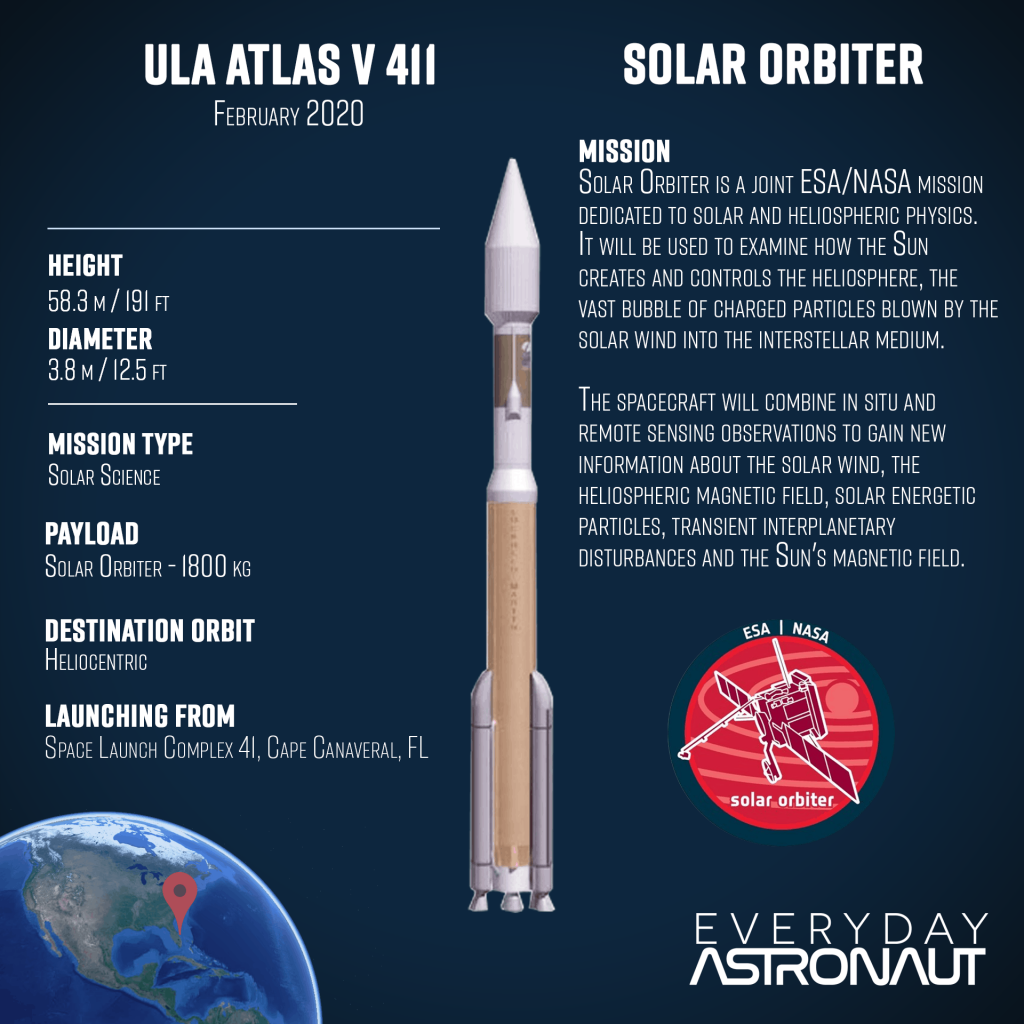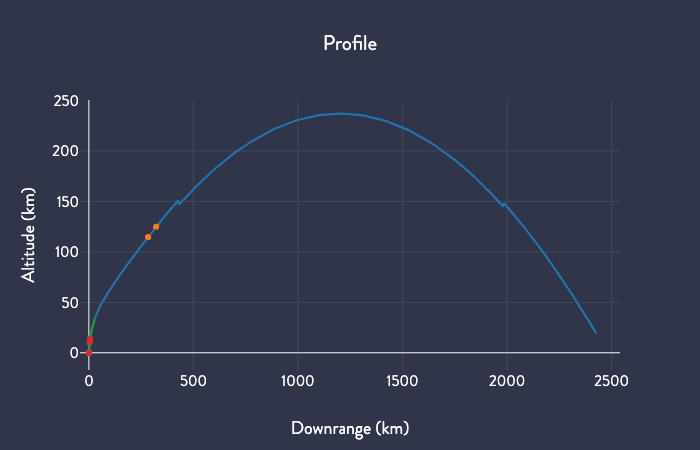Launch Window(Subject to change) | February 10, 2020 – 04:03:00 to 06:03:00 UTC February 9, 2020 – 11:03 PM to 1:03 AM EST |
|---|---|
Mission Name | Solar Orbiter, a mission to the Sun! |
Launch Provider | United Launch Alliance (ULA) |
Customer | European Space Agency (ESA) |
Rocket | Atlas V 411 |
Launch Location | Space Launch Complex-41, Cape Canaveral Air Force Station (CCAFS), Florida |
Payload mass | 1,800 kg (~4,000 lb) |
Where are the satellites going? | Solar Orbit (eventually between 1.2 Astronomical Units (AU) at aphelion and 0.28 AU at perihelion) |
Will they be attempting to recover the first stage? | No, this is not a capability of ULA |
Where will the first stage land? | It will crash into the Atlantic Ocean (about 2,500 km downrange, thanks to Declan Murphy at FlightClub.io for this research!) |
Will they be attempting to recover the fairings? | No, this is not a capability of ULA |
Are these fairings new? | Yes |
This will be the: | – 137th flight for ULA – 82nd launch for an Atlas V – 6th flight in the 411 configuration |
Where to watch | Official Livestream Maybe even more fun you can watch with Tim Dodd, the Everyday Astronaut, starting at T minus 1 hour! Come ask questions and join the conversation live! |

What’s all this mean?
We are going back to our star!! Solar Orbiter is a spacecraft built by the European Space Agency to study the inner heliosphere and its overall effects on solar radiation. How’s it gonna get there? The launch provider, United Launch Alliance (ULA) has this job. Their mighty Atlas V rocket will soar into the Floridian skies propelling Solar Orbiter to space on its 3.5 year journey to the Sun.
The configuration of the Atlas V this time is 411. But wait, what does “411” mean, anyway? The last three numbers or letters of the rocket name of an Atlas V denote the configuration of the rocket. The first number/letter shows the fairing diameter size (in meters, of course). The number 4 obviously means a 4 meter fairing. The second number determines the number of strap on solid rocket boosters (SRBs). It can range from 0 to 5, and in this case, there is only one on the side of the center core. The third and final number refers to the number of engines on the Centaur Upper Stage, which can be either one or two. In this case there will be one engine. The only time that there have been two engines (while on an Atlas V) was on Starliner’s OFT-1. So to review, this rocket has a 4 meter fairing, one solid rocket boosters, and one engine on the Centaur Upper Stage.

The diagram below shows a detailed simulation of just how far this booster will travel before crashing down into the Atlantic Ocean after Main Engine Cut-Off (MECO) and the Centaur upper stage ignites on its way to orbit! Thanks Declan from FlightClub.io for doing this specially for this article!

What about the payload?
During some sections of its orbit, it will be able to work in cooperation with NASA’s Parker Solar Probe currently in orbit around our sun. There are four main questions that Solar Orbiter is trying to answer:
What drives the solar wind and where does the coronal magnetic field originate from?
How do solar transients drive heliospheric variability?
How do solar eruptions produce energetic particle radiation that fills the heliosphere?
How does the solar dynamo work and drive connections between the Sun and the heliosphere?
It will be able to do this with a multitude of onboard instruments. Some of the in situ instruments include a Magnetometer (MAG), a Radio and Plasma Waves detector (RPW), a Solar Wind plasma Analyser SWA, and an Energetic Particle Detector (EPD).

Another set of instruments is in the group, remote sensing. These include STIX: X-ray Spectrometer/Telescope, SPICE: Spectral Imaging of the Coronal Environment, SoloHI: Heliospheric Imager, PHI: Polarimetric and Helioseismic Imager, METIS: Coronagraph, and EUI: Extreme Ultraviolet Imager. Those are labeled on the diagram above.
For more information and a very detailed description of each one of the instruments visit ESA’s Webpage on Solar Orbiter!
Keep an eye on this Prelaunch Preview and SpaceLaunchNow for T-0 updates and more!





Hi Tim!
My name’s Alex. I am a Spanish aerospace engineer which has been working for a number of years on some of the instruments onboard Solar Orbiter (among other cool missions, like ExoMars, Chang’E 4, Dream Chaser, hehe). I am part of a research institution called IDR (Microgravity Instituto Ignacio Da Riva, we are @IDR_Aeronautic on twitter but I believe we have to work strong on our internet capabilities) First of all I love your channel, I am more than subscribed and I find your videos really awesome. I learn a lot from them even having a Phd in aerospace engineering.
The reasons why I am been writing are two:
*First of all, I am traveling with a group of colleagues to Cape Canaveral as we have been invited by NASA to the launch of Solar Orbiter. I was wondering if you could tell us of some cool companies we may visit (aside from all the typical). I don’t know, maybe Boeing has a Starliner inside their HQ as in your video or something!! And maybe if you could give us a small hand on who to ask to get some permits. I am driving myself crazy searching and not finding any useful info!
*Last, but not least, if you are attending the launch I would love to buy you a couple beers and me and my colleagues would love to chat with you for a while. I thought of this recently and I am not able to put you as my +1 for the launch (From Banana Creek), sorry for that.
Kindest regards,
Alex